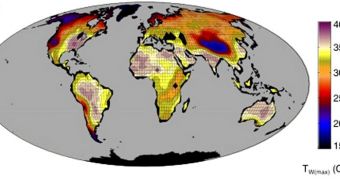A series of new computer simulations shows that Earth could become too hot for humans within the next few centuries, and not over thousands of years, as originally estimated. The computer models were based on reasonable worst-case scenarios that were derived from current global warming trend. Researchers behind the initiative assumed that greenhouse gases such as carbon dioxide, methane and nitrogen oxide will continue to be emitted at their current rates, and then modeled their influence on the planet's atmosphere accordingly, LiveScience reports.
The investigation showed that global temperatures would eventually increase so much that they would become unbearable, and even lethal, for humans. Scientists were also able to calculate the highest tolerable “wet-bulb” temperature humans can endure. This is an index that shows how temperature is perceived by the human body when wet skin is exposed to moving air masses. For the first time in history, there is a distinct possibility that this threshold will be exceeded.
Such an event never happened before in the millions of years hominids and modern humans have been roaming the planet, but researchers know of another instance when this happened, some 50 million years ago. Purdue University Earth and Atmospheric Sciences Division expert and study team member Matthew Huber believes that exposure to wet-bulb temperatures above 95 degrees Fahrenheit for more than six consecutive hours can create intolerable, lethal levels of stress in humans, as well as in a wide array of other higher mammals as well.
“The wet-bulb limit is basically the point at which one would overheat even if they were naked in the shade, soaking wet and standing in front of a large fan. Although we are very unlikely to reach such temperatures this century, they could happen in the next,” says University of New South Wales (UNSW) Climate Change Research Center expert Steven Sherwood, who was also the lead author of the new investigation. Details of the findings appear in the May 6 issue of the esteemed publication Proceedings of the National Academy of Sciences (PNAS).
“We found that a warming of 12 degrees Fahrenheit (roughly 7 degrees Celsius) would cause some areas of the world to surpass the wet-bulb temperature limit, and a 21-degree warming would put half of the world's population in an uninhabitable environment. Whole countries would intermittently be subject to severe heat stress requiring large-scale adaptation efforts. One can imagine that such efforts, for example the wider adoption of air conditioning, would cause the power requirements to soar, and the affordability of such approaches is in question for much of the Third World that would bear the brunt of these impacts. In addition, the livestock on which we rely would still be exposed, and it would make any form of outside work hazardous,” the expert concludes.

 14 DAY TRIAL //
14 DAY TRIAL //